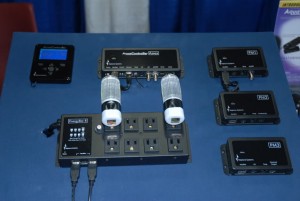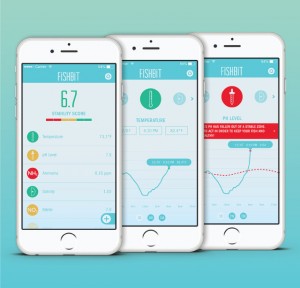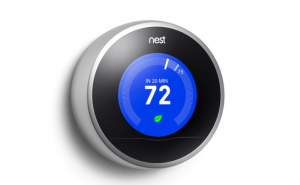 While watching an interview with Fishbit creator Nathan Levine, I noticed a surprising statistic. One out of every ten people who enter the marine aquarium hobby stay in it past 18 months. Is it really surprising? The hobby is expensive, time consuming and often equipment is difficult to implement when you’re new. It also can be disastrous to a home, in the event of a large water leak. I’ve known aquarists who enjoyed the hobby and maintained moderate success, but once their floors or ceilings were ruined by saltwater, they decided to throw on the towel, quite literally. Nathan Levine brings up an important point about controllers, in that they can take some of the guess-work out of hobby success, but are often so difficult to use they alienate many aquarists.
While watching an interview with Fishbit creator Nathan Levine, I noticed a surprising statistic. One out of every ten people who enter the marine aquarium hobby stay in it past 18 months. Is it really surprising? The hobby is expensive, time consuming and often equipment is difficult to implement when you’re new. It also can be disastrous to a home, in the event of a large water leak. I’ve known aquarists who enjoyed the hobby and maintained moderate success, but once their floors or ceilings were ruined by saltwater, they decided to throw on the towel, quite literally. Nathan Levine brings up an important point about controllers, in that they can take some of the guess-work out of hobby success, but are often so difficult to use they alienate many aquarists.
Would we use a mobile phone if it was overly complicated, taking hours to set up and months to learn how to place a phone call? How about an office printer, car radio – the list goes on and on. Technology works best when it’s simple, quick and within a short period of time it’s working for us, making our lives easier. Aquarium controllers today are all about control and providing real-time data, but how they provide that control has remained a problem. To this effect the market for aquarium controllers has never really developed. It’s safe to say if something easily implemented, conservatively priced and fool proof could aid marine aquarists in having a healthy tank, we all would be doing it. Controllers provide some protection against failure, but it’s wrapped in a high cost, and often high user difficulty.
Does a marine aquarium require a controller?
 The short answer is no – no more than any home, vehicle or building requires an internet connection or cable TV. Marine aquariums have existed for years without controllers, so there is no reason to say they require them for success. However, as we have learned, once technology reduces the burden and increases success in any field, it often becomes a part of life that would be tough to do away with. Imagine a day without an internet connection, or phone, or tablet or any device that is with us today nearly 24/7. I don’t need my Apple Watch to tell me when to stand up from my desk at the office, or track my evening walk, but it sure is nifty to have. I don’t need access to a nearly limitless library of TV shows, movies and music; but when my 3 year old daughter is screaming that she wants to watch Doc McStuffins – it comes in awfully handy.
The short answer is no – no more than any home, vehicle or building requires an internet connection or cable TV. Marine aquariums have existed for years without controllers, so there is no reason to say they require them for success. However, as we have learned, once technology reduces the burden and increases success in any field, it often becomes a part of life that would be tough to do away with. Imagine a day without an internet connection, or phone, or tablet or any device that is with us today nearly 24/7. I don’t need my Apple Watch to tell me when to stand up from my desk at the office, or track my evening walk, but it sure is nifty to have. I don’t need access to a nearly limitless library of TV shows, movies and music; but when my 3 year old daughter is screaming that she wants to watch Doc McStuffins – it comes in awfully handy.
Controllers have a similar place on our aquariums. Once you have one, eventually you wonder how you managed without. The difference between a controller and other forms of technology, you have to be dedicated to take the time and spend the money to implement them. An Apple TV costs 200 bucks and is up and running within a few minutes. For a full bodied controller, you’re going to shell out nearly 1,000 bucks and you might have it partially unboxed in a few minutes. There are multiple power bars that communicate with the controller, the main unit which displays temperature, ph and other information, a host of modules that control everything from lighting to ORP and cables and connections required for each. Just mounting a controller and all the modules is a challenge, and then getting communication between a PC and controller takes time, and may require direct access to a router network port.
For many, when they open a new controller suddenly they are overwhelmed, a feeling as though they’ve stepped outside of their technology comfort level. I’ve known a few aquarists who put the controller back in the box and returned it, without plugging in a single cable. Seeing modules, power bars, control units and countless cables spread around makes some aquarists suddenly feel like having such a detailed level of control isn’t really needed. Even once the unit is up and running there are mandatory firmware updates, and depending on what unit you opt for, some of these can be painstaking to install.
Is the time, money, control equation worth it?
 I’m a nerd, and even studied computer science in college and interned several years for a software design firm. Computers and technology come easily and quickly for me. Like Nathan Levine, it took me about 2 hours to set-up a complete controller and have all the functions up and running. This doesn’t take into account the time needed for measuring, drilling, driving screws and all the other necessities to get the system properly mounted on the wall, away from any risk of getting splashed. For someone like me, who will eventually figure out all the controllers’ functions and also be able to work through firmware updates, yes a controller is worth it.
I’m a nerd, and even studied computer science in college and interned several years for a software design firm. Computers and technology come easily and quickly for me. Like Nathan Levine, it took me about 2 hours to set-up a complete controller and have all the functions up and running. This doesn’t take into account the time needed for measuring, drilling, driving screws and all the other necessities to get the system properly mounted on the wall, away from any risk of getting splashed. For someone like me, who will eventually figure out all the controllers’ functions and also be able to work through firmware updates, yes a controller is worth it.
For folks who struggle to use an iPhone, laptop computer and many other tech devices, it’s unlikely they will have the patience or resources to fully exploit an aquarium controller. For some aquarists their controller has become a 1,000 dollar ph monitor, simply because they can’t figure out the rest of the functions. If you’re squeamish about communications technology then you’ll likely be very squeamish about an aquarium controller. Sadly, having someone install a controller for you is a less than perfect option. Probes will need calibrated, firmware installed and constant changes will need made as aquarium equipment is upgraded and changed. Like many other tech toys, you need to understand how controllers work to successfully use one and you may as well start learning during initial set-up.
Are there other options?
 Can you have constant reporting on your aquarium’s conditions, along with automated control, without a full bodied aquarium controller? It’s important that aquarists think about what controller actually means. Anything that looks at temperature, ph, ORP or any element of our aquariums and automatically takes action to keep it in a certain range, is a controller. Heaters have controllers, ph controllers are common as well as ORP controllers. Most are easily set-up as they only control one aspect of our aquariums and aren’t a single system offering a wide range of features. Also, most standalone ph and ORP controllers don’t offer internet access to make changes from far away.
Can you have constant reporting on your aquarium’s conditions, along with automated control, without a full bodied aquarium controller? It’s important that aquarists think about what controller actually means. Anything that looks at temperature, ph, ORP or any element of our aquariums and automatically takes action to keep it in a certain range, is a controller. Heaters have controllers, ph controllers are common as well as ORP controllers. Most are easily set-up as they only control one aspect of our aquariums and aren’t a single system offering a wide range of features. Also, most standalone ph and ORP controllers don’t offer internet access to make changes from far away.
You can control an aquarium automatically without a controller, and many aquarists do it. There is a stark difference between this level of control and what a full control system provides. Controllers really are the only equipment that can save your tank from a preventable equipment failure or sudden change, because they put you in control of systems that can reverse the effects of ph swings, heaters sticking, any of those sorts of disasters.
 Though today with the rise of Nest thermostats and cameras, along with a bevy of other “smart home” devices, a resourceful aquarist can make use of easy tech to serve our aquariums. How about a simple Pinpoint ph monitor watched by a Nest cam? Or a smart thermostat that tells you the temperature in your house, and verifies that the air conditioning is running? Often these devices are easier to set-up than aquarium controllers, and while they don’t serve the same purpose, they certainly offer some level of far-away monitoring. Combine this with equipment like Ecotech’s Vortech and radion, or the upcoming return pump, of the AI Hydra, that offers control online via simple to use software and suddenly aquarium equipment is evolving on its own to be controlled from far-away. Using this type of equipment greatly reduces the need for a full aquarium controller.
Though today with the rise of Nest thermostats and cameras, along with a bevy of other “smart home” devices, a resourceful aquarist can make use of easy tech to serve our aquariums. How about a simple Pinpoint ph monitor watched by a Nest cam? Or a smart thermostat that tells you the temperature in your house, and verifies that the air conditioning is running? Often these devices are easier to set-up than aquarium controllers, and while they don’t serve the same purpose, they certainly offer some level of far-away monitoring. Combine this with equipment like Ecotech’s Vortech and radion, or the upcoming return pump, of the AI Hydra, that offers control online via simple to use software and suddenly aquarium equipment is evolving on its own to be controlled from far-away. Using this type of equipment greatly reduces the need for a full aquarium controller.
The final verdicts:
 Controllers need to evolve like so much technology has and become easy to use. Ecotech’s ecosmart live is a great example. The reef link is easily set-up, remains pretty stable connection wise, and works flawlessly to connect aquarium equipment to a mobile device or computer. Firmware updates are automatic and simply download and install themselves. While it won’t be a breeze for the less than tech savvy, they should be able to figure it out, especially with the aid of customer support. The hobby needs that kind of product that controls everything. neptune Systems is constantly evolving their product to be more user friendly, and Fishbit’s development team is addressing many of these concerns. While the Mindstream looks to be a revolutionary monitor, it isn’t going to offer any control. If I was in the market for a controller right now I would hold on and wait to see what Fishbit can do, before making the investment. The thought that an easy to use aquarium controller might be just around the corner is exciting, to say the least.
Controllers need to evolve like so much technology has and become easy to use. Ecotech’s ecosmart live is a great example. The reef link is easily set-up, remains pretty stable connection wise, and works flawlessly to connect aquarium equipment to a mobile device or computer. Firmware updates are automatic and simply download and install themselves. While it won’t be a breeze for the less than tech savvy, they should be able to figure it out, especially with the aid of customer support. The hobby needs that kind of product that controls everything. neptune Systems is constantly evolving their product to be more user friendly, and Fishbit’s development team is addressing many of these concerns. While the Mindstream looks to be a revolutionary monitor, it isn’t going to offer any control. If I was in the market for a controller right now I would hold on and wait to see what Fishbit can do, before making the investment. The thought that an easy to use aquarium controller might be just around the corner is exciting, to say the least.









Ya gotta have a plan and know what to expect, it’s a long haul hobby for sure!!
Been in the hobby for over 12 years, just bought a controller a month ago. Best investment next to my whole house standby generator I put in to protect my tanks when the power goes out.
If things are set up right there’s no problem not too much maintenance when it’s going correctly